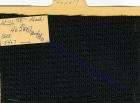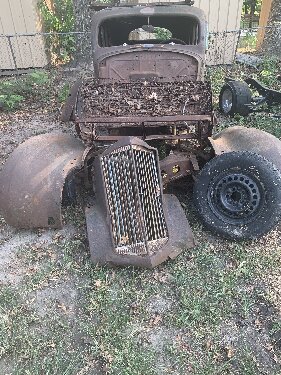|
Re: Wire wheels and Narrow Radial Tires
|
||||
|---|---|---|---|---|
|
Home away from home
|
I shopped and measured a lot and decided that these wheels will fit my Packard 2300 series as long as the tires are not too fat. The new wheels have a zero offset and a 6 inch wide rim. The original wheels are either 5 or 5.5 inches wide, I am not sure which was standard on this car. The stock wheels have a small negative offset which puts the wheels slightly more inboard than the new wheels. The difference is only about a quarter inch. This should not be an issue.
The narrow tall tires I am getting are as big an OD (29.4) as you can put on the car without concern about hitting the tread against the front wheel well at the rear of the tire. The width of the new tire (7.7)is smaller than the tires I have on it now and they now clear the rear fender skirt by one inch. The critical item on the Carribean wheels I have on the car now is the diameter of the center hole. The Carribean wheels interfere with the front hub and it will not allow the wheels to seat against the hub flange as it should. The new wheels have a center hole slightly bigger than the stock Packard wheels, so they sould fit fine. I am due to receive the wheels and the tires in early December. I will send a new posting if there are any issues. I shopped around a lot and the total cost of wheels, tires, shipping, and installation comes to just under $2500. It is a lot of money, but it really impacts the look of the car. Also the tall tires will give me a cruising speed the same as origional Packard tires.
Posted on: 2009/11/25 17:26
|
|||
|
||||
|
Wire wheels and Narrow Radial Tires
|
||||
|---|---|---|---|---|
|
Home away from home
|
My 1950 Packard 2301 Touring Sedan came to me with a set of Packard wire wheels installed. They look really nice, even though they were not available on that 1950 car. I serviced the brakes, etc. and discovered that the crook that sold me the car installed wheels that would not fit. The center hole in the wheel is perhaps 1/4" smaller than required to clear the OD of the front hub. To "fix" the problem he installed spacers under the wheels and screwed in the lug bolts a few turns, torqued the hell out of them so they would not fall off right away, and sold me the car. As an engineer with wheel manufacturing experience I can tell you this won't work for long, even if I find some longer lug bolts. Thick spacers cause bending stress on the lug bolts and eventually they break.
I plan to toss the wheels and the tiny brand new P195/75R-15 whitewall radials and replace both with proper new items. Does anyone out there have experience with the reproduction Packard wire wheels being sold by Kanter, Coker, and others? Do they fit the 2300 series Packard OK? Also I found some new 700R-15 wide whitewall tires that have the look of the original tires (narrow tread, tall profile, but radials). Does anyone have any comments about these tires? They are manufactured by Sumitomo and sold by The Whitewall Candy Store in Orange, CA. I like these tires because they look authentic, rather than the fat radials normally seen on Packards. The cost is $216, about the same as the fat radials.
Posted on: 2009/11/23 18:37
|
|||
|
||||
|
Re: Packard International Membership Meet and Swap Meet - Jan 29th-31st, 2009
|
||||
|---|---|---|---|---|
|
Home away from home
|
I will definitely attend, hopefully with a roadworthy Packard.
Fred Puhn
Posted on: 2009/11/19 15:47
|
|||
|
||||
|
Re: Repairing Ultramatic
|
||||
|---|---|---|---|---|
|
Home away from home
|
My Packard streamliner is now repaired with a fully working Ultramatic transmission. It shifts nice now, does not slip, and it declutches when I stop. The repair shop I now highly recommend is Ray's Transmission in Lakeside, California (San Diego County). Their shop phone number is (619)561-0930. The total cost of everything was slightly more than $2300, and this included rebuilding the transmission, replacing u-joints, replacing the rear end pinion seal, and fixing the exhaust leak. This price was less than any of the three other prices I obtained.
Posted on: 2009/11/19 15:44
|
|||
|
||||
|
Re: Repairing Ultramatic
|
||||
|---|---|---|---|---|
|
Home away from home
|
On a local reference I took the Packard to a local shop in the town of Lakeside. Two very experienced guys work there and they have lots of old cars in work. They first pulled the pan and found bits of band lining in the oil. Then they pulled the transmission out and showed me all sorts of problems with the worn clutch facings and the crumbling bands. They got the parts, assembled everything, and put it back together last Friday. They said the car worked fine except for the darn problem I started with, not releasing the clutches when slowing to a stop. They were going to fix either the governor or the valve body they said. More news to come. I will give you the name of the shop after I drive the car and get the final bill. So far they appear quite good and honest.
Posted on: 2009/11/15 22:41
|
|||
|
||||
|
Re: V-belt for 1947 356
|
||||
|---|---|---|---|---|
|
Home away from home
|
On my 1950 Packard 288 I had an old belt that fit barely (stretched due to age I guess) and a new one that was too short by a small amount. I just went to Napa with the old belt and said I wanted the next size longer. They gave me one that fit, but it is the cogged type. I suggest Napa because they are handy and the price was less than the repro that doesn't look original. I would love to get a belt that was the old solid construction however, just for the original appearance. I do not know if they make that solid type anymore.
Posted on: 2009/11/8 14:30
|
|||
|
||||
|
Re: First ever restore/repair 51 touring sedan help
|
||||
|---|---|---|---|---|
|
Home away from home
|
I was asked to define what I (an old car collector in San Diego) call "rust". There are several stages in my description of rust:
1. Surface rust - This is rusty metal that can be restored by surface finishing such as blasting, sanding, coating, filling, etc. It is only cosmetic and the metal is near full thickness. 2. Rusty metal that is thin - This is material that is structurally weakened by corrosion to the point where it may break under applied loads. Making it look good may be possible but it could be functionally dangerous. Fixing it requires cutting and welding in new metal if cracking is an issue. 3. Holes in the metal - This is what people from the East call "rust". People also call it "cancer" or the "tin worm". This can only be fixed by cutting the surrounding thin material away and welding in new metal. Fiberglass patching or other Mickey Mouse cosmetic fixs don't work. Cars in Southern California generally are scrapped if they have cancer. 4. Structurally falling apart - This we call scrap. The part needs replacing. All the other ones near it will have serious problems too. 5. Hidden rust - Any or all of the above is very likely to have hidden rust along with the visible. Hidden rust can include holes in the metal covered by putty, paint, fiberglass, or even riveted-on aluminum sheet. The worst part of rust is the hidden part because it is typically between adjacent parts or underneath something else that first has to be removed. Also you would have never paid that much for the car if you saw the hidden rust! To answer the question about what I call rust, I would define it as anything except "surface rust" because fixing it costs mucho money (or valuable time in the case of a home craftsman). From what I can tell from ads, many people in the East selling a car use the word "rust" when the car has cancer, but not before.
Posted on: 2009/11/3 15:59
|
|||
|
||||
|
Re: 2300 series options
|
||||
|---|---|---|---|---|
|
Home away from home
|
That you so much Clipper47. This is exactly what I was looking for. Now I can shop properly.
Posted on: 2009/11/2 13:46
|
|||
|
||||
|
Re: First ever restore/repair 51 touring sedan help
|
||||
|---|---|---|---|---|
|
Home away from home
|
I have been messing with old cars for decades and have made lots of mistakes on projects like yours. here is my experience:
1. Always inspect the car in person before buying it. If it has rust walk away unless you like wasting money. 2. My experience is that the cheapest way to own an old car is to buy the best one you can afford. The most expensive way is to buy the cheapest one you can find. 3. My own recent experience with my 1950 Packard is a real example. See my profile (Fred Puhn 1950 2301 Touring Sedan)for the sad details. I was scammed while trying to follow advice #2 because I violated advice #1 above. 4. The most expensive part of a restoration is fixing rust. Most of the damage is hidden. Unless it is a very valuable car (say $50,000 or more)it will not be feasible to fix extensive rust and come out ahead. Walk away and save money by paying more for a rust-free car. On one of my cars I paid $20,000 for it and then spent $70,000 fixing rust! Most of the rust was hidden from view. Luckily the car is worth more than that, but a 50s Packard is not in that economic class. 5. When a car sits for a long time the following things need attention, with priority in the following order; 5.1 Anything with fluid (fuel, water, brake fluid, oil)in it needs fluid changing, cleaning, and probably repair. 5.2 Anything made of rubber (belts, hoses, gaskets, seals, tires) will need inspection and probably replacing. 5.3 The electrical system will need sorting out due to bad corroded connections and possibly bad insulation 5.6 The engine may be stuck, damaged, corroded, sludged up, or otherwise bad. Test everything first before driving it. 5.7 Everything needing lubrication needs lubrication. 5.8 If the car needs paint, interior, and chrome plan on spending at least $10,000 for a cheap job and more for quality. Best of luck on your new project.
Posted on: 2009/11/2 13:37
|
|||
|
||||








